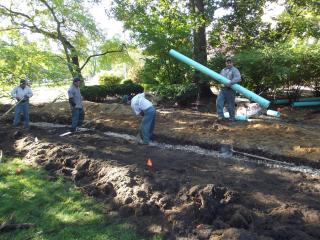Advertisement
A rain garden is a natural area designed to trap water that would otherwise end up in storm sewers. It allows the water to slowly percolate into the soil, replenishing underground water sources. At Evanston, the two rain gardens collect virtually all of the water that flows off the roof of the congregation’s building.
The church dedicated its second rain garden in June. It is adjacent to the lawn area the congregation uses for church picnics, wedding receptions, a summer camp, and other events.
“What I think these gardens do is raise our environmental awareness,” said Sandra Robinson, executive operations director for UCE. “It reminds us there’s a reason for having them and that’s to care for the earth.”
The gardens have been planted with prairie grasses and other native plants. A bit of education had to be provided to make members aware the gardens are not available for people to use. “They’re only for viewing, not walking,” said Robinson, so that the soil will absorb as much water as possible.
The gardens are essentially large swales planted with native plants. Large underground pipes connect to the roof downspouts.
Alex Sproul, a longtime member of the congregation, is one of the strongest advocates for the rain gardens. He noted that despite being just a mile west of Lake Michigan, Evanston and the entire Chicago metro area face a potential water shortage. Illinois cannot legally draw much more water than it currently does from Lake Michigan. That means it’s important to recharge the groundwater supply through the use of rain gardens and other means.
“By restoring water to the local water table it also restores the lake,” Sproul said. “Our project by itself is not going to solve the water shortage, but we figured we were in a good position to take a leadership role and be influential.”
Local water authorities praised the rain gardens. Debra Shore, a commissioner of the Metropolitan Water Reclamation District of Greater Chicago, said at the dedication of the second garden, “Rain gardens … are important because they seat us in right relationship to the land. By capturing rain where it falls we act as caring stewards.”
The UCE rain gardens are some of the first in the Evanston area. “People are very proud and pleased that we are forerunners in Evanston in this type of change,” said Robinson.
The latest garden was dedicated to member Bill Fischer, who died on Earth Day in 2013. “He was very involved in environmental issues and he was one of the people who wanted to make this garden happen,” said Robinson. The earlier garden was named for Marjorie Fisher, a member who helped start the Green Sanctuary program at UCE.
Together the gardens take up all of the runoff from the 8,100 square feet of roof area of the congregation’s building. “We’re talking around 25,000 cubic feet of water a year that will now go into the groundwater instead of through the sewer system,” said Sproul.
The smaller garden, which cost around $5,000, is 500 square feet and takes 40 percent of the water. The larger one, at 800 square feet, cost $8,000 and takes the remainder. The gardens were paid for mostly from contributions in memory of Fisher and Fischer.
The water runoff seldom actually pools in the gardens, said Sproul. “We have very sandy soil and we get fast depletion. If we had clay soil we’d need a considerably larger garden area.”
The congregation engaged engineers and then landscapers to ensure that the gardens would be large enough to handle the roof runoff. And while people generally have to stay out of the gardens, they’re a source of inspiration.
“It’s pretty and functional at the same time,” said Robinson. “I find it very meditative just to be next to it.”
Photograph (above): Laying pipe for the rain garden, September 30, 2013 (Andy Fisher).
Related Resources
- Rain Gardens: A Beautiful Way for You to Reduce Runoff Pollution. Resources from the Wisconsin Department of Natural Resources. (dnr.wi.gov)
